Nvidia GeForce RTX 2070 Max-Q Review
Nvidia unveiled RTX laptops early on 2022 and the first models sporting the GPUs are making it to market just now. Today we're checking out Nvidia'due south new GeForce RTX GPUs for laptops, starting with the RTX 2070. Hopefully in the nigh hereafter we'll get to do a full performance breakdown of each RTX laptop offering, only we have to outset somewhere, and thank you to Gigabyte we're kicking things off with the middle of the pack RTX 2070 Max-Q variant.
Of course, the desktop RTX 2070 has been available for a while and we know exactly how it performs. However the laptop version of the chip is not an identical re-create of the desktop card, which may pb to some confusion considering how Pascal (GTX 10 series) and at present the GeForce 20 series are different on the mobile front.
With Pascal there were 3 master offerings: the GTX 1060, GTX 1070 and GTX 1080. Excluding the Max-Q variants for a moment, the main regular laptop versions were very like to their desktop counterparts. The GTX 1060, for instance, had the same CUDA core count and the base of operations clock was a little lower, merely the boost clock was but 38 MHz lower than the desktop card. For the near part, in a good laptop pattern, the mobile GTX 1060 performed similar a desktop GTX 1060.
Then there was the GTX 1080, once more same CUDA core count and even the same boost clock. The GTX 1070 was a petty different in that the laptop variant had a slight increment to CUDA cores along with a slight decrease in clocks, merely the cease outcome was that a laptop GTX 1070 performed around the mark of a desktop GTX 1070. Times were simple.

Then Nvidia introduced Max-Q variants, which were underclocked versions of the same GPUs designed to slot into sparse and low-cal systems that perhaps didn't take the cooling capabilities of the usual mesomorphic gaming laptops. Many didn't similar Max-Q, but in the applied sense information technology immune for more performance in slimmer designs, which we approve of. It wasn't quite the full performance of the labelled GPU, merely meliorate than the tier below, and considering most laptops that had Max-Q GPUs were marketed as such, there wasn't much defoliation.
With the GeForce 20 series, Nvidia has taken things a step farther.
Nosotros nevertheless have Max-Q laptops, simply the regular non Max-Q GPUs accept too received meaning clock speed cuts compared to the desktop versions. We won't go through every variant, but focusing on the RTX 2070 we can meet where the cuts have occurred.
The 2070 GPU has the aforementioned CUDA core count, 2304 cores, which is why Nvidia tin phone call this an RTX 2070. It is the aforementioned physical GPU. But clock speeds are significantly lower. The desktop card has a 1410 MHz base along with a 1620 MHz boost, which goes up to 1710 MHz for the Founders Edition card. Compare that to the laptop variant, which receives a 1215 MHz base and a max heave clock of 1440 MHz. And that'southward the fully fledged mobile version.
The 2070 Max-Q model sits at an 885 MHz base clock and 1185 MHz boost clock. Max-Q clocks take ever been lower than the not Max-Q models, but now the gap has widened significantly compared to the last few years.
There's a reason to all of this, and it relates to the TDP. Not a lot of people care almost this metric in desktop cards, but for laptops it's a crucial figure as the laptop maker has to pattern a cooler that can handle the TDP of the GPU within tight space constraints. With Pascal, nosotros had the GTX 1070 at 150W on the desktop, and 115W for full laptops. Merely with the RTX 2070, that'south now a 175W part, only still just 115W for laptops. The merely fashion to hit that TDP with the aforementioned GPU is to put it on a leash and lower clocks.

This besides relates to Nvidia's shifting up of production tiers. The GTX 1060 used to be 120W, but with the RTX 2060 it'due south now 160W which occupies the place where the GTX 1070 used to sit. The RTX 2070 is 175W, which is more than like a GTX 1080. And then the RTX 2080 comes in at 215W, a place where laptops never used to go.
With this predicament Nvidia could have gone in two directions: they could have fabricated RTX laptop GPUs equivalent to RTX desktop GPUs, which would have meant the RTX 2070 replaces the GTX 1080 in designs capable of handling that TDP. The RTX 2060 would then supervene upon the GTX 1070, and the RTX 2080 couldn't exist used. But Nvidia didn't want to practise that.
Instead they chose option two: downclock the GPUs so that an RTX 2070 tin can replace a GTX 1070 and so on, creating a simple swap in generations. Even though information technology makes the laptop versions pretty unlike to the desktop chips.
We've probably spent too much time talking well-nigh all of this, but our last point on the thing is that with Nvidia choosing the downclocking route, we feel using the name RTX 2070 for the laptop RTX 2070 isn't authentic anymore, and we experience this series should accept added an M at the end of the characterization as we saw on generations prior, then this should be the RTX 2070M.
But a few more notes worth adding. Similar the desktop card, the RTX 2070 for laptops uses 8GB of GDDR6 at "up to 14 Gbps" according to Nvidia specs. That means 14 Gbps for the fully fledged version, and 12 Gbps for Max-Q. Same 256-bit bus. RTX functionality likewise remains, so the Tensor and RT cores are present, just due to the GPU running slower, performance won't be the aforementioned. Nvidia cites up to 38T RTX OPS and 5 Gigarays per second for the laptop RTX 2070, compared to 42T RTX OPS and half-dozen Gigarays for the reference RTX 2070 desktop carte.
The focus of today'south review is the Max-Q variant of the RTX 2070, which belongs to the first RTX laptop we've got our hands on. Evidently, Max-Q GPUs are virtually popular in the thin and light/gaming ultraportable laptop category. This Max-Q laptops ship with an unchangeable power limit and they cannot be overclocked to the level of a total RTX 2070. You can practise some basic core and memory clock overclocking, but the ability limit is the primary limitation here.
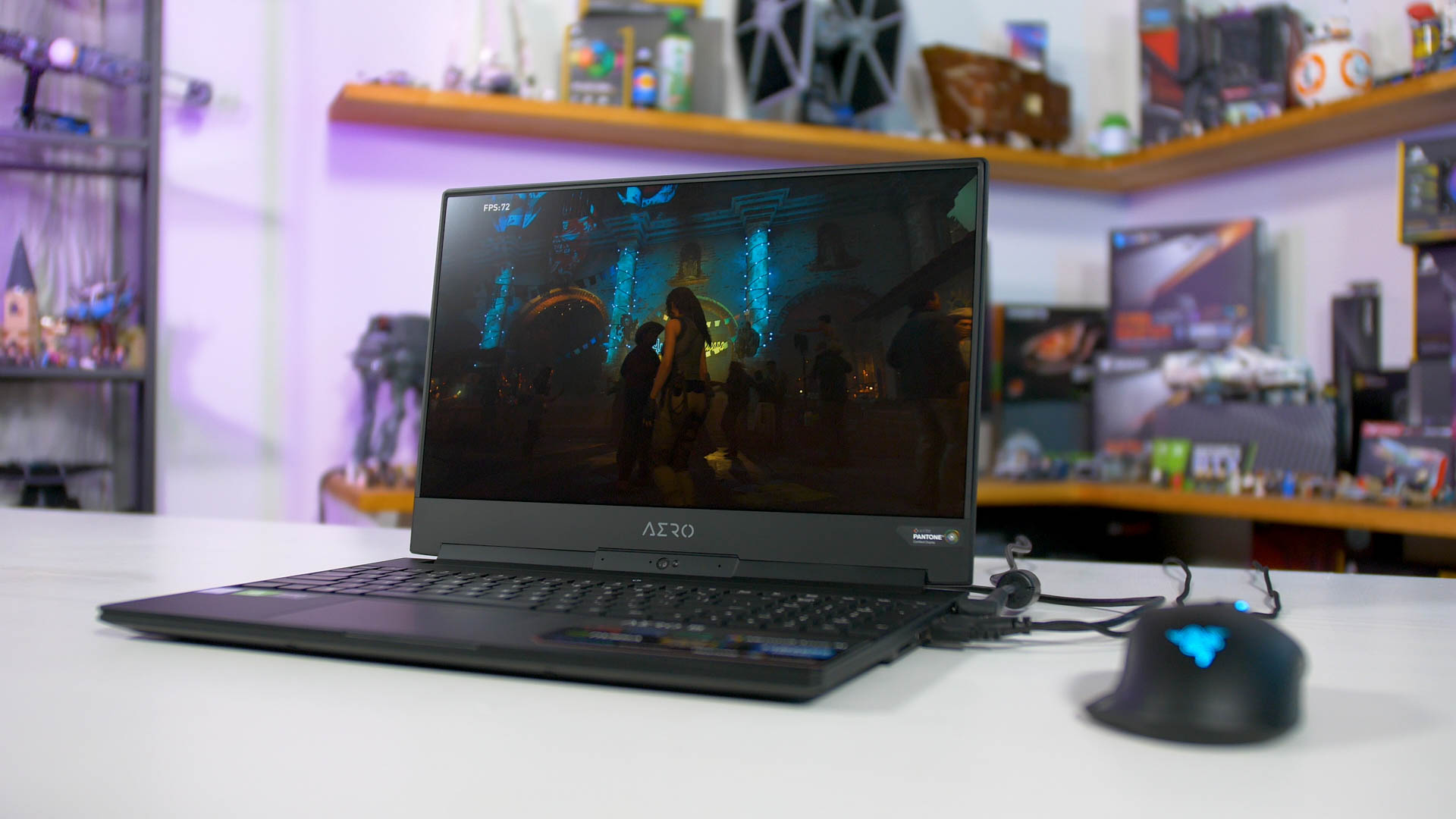
Thanks go to Gigabyte for sending in their brand new Aero xv X9 which packs the RTX 2070 Max-Q. We also accept on paw the previous gen Aero 15X with the GTX 1070 Max-Q inside, and so we can run some apples-to-apples comparisons. Because both laptops apply the same design, every bit well as largely the aforementioned hardware and cooler, this makes comparing the RTX 2070 to the GTX 1070 pretty piece of cake.
The Gigabyte Aero xv X9 packs Intel'southward half-dozen-core Cadre i7-8750H, the become-to selection for gaming laptops, which you'll also see used on most of the other laptops in our comparison. Our review unit was kitted out with 32GB of dual-channel DDR4, the same configuration in the Aero 15X with the GTX 1070. The testing was focused on 1080p gaming.
It's also cardinal to notation the Aero 15 X9 was tested with the fan mode set to 'gaming'. This delivers noticeably better performance than the quieter 'counterbalanced' manner. Both laptops were as loud as each other, which over again cuts out a further variable when comparing the RTX 2070 with the GTX 1070.
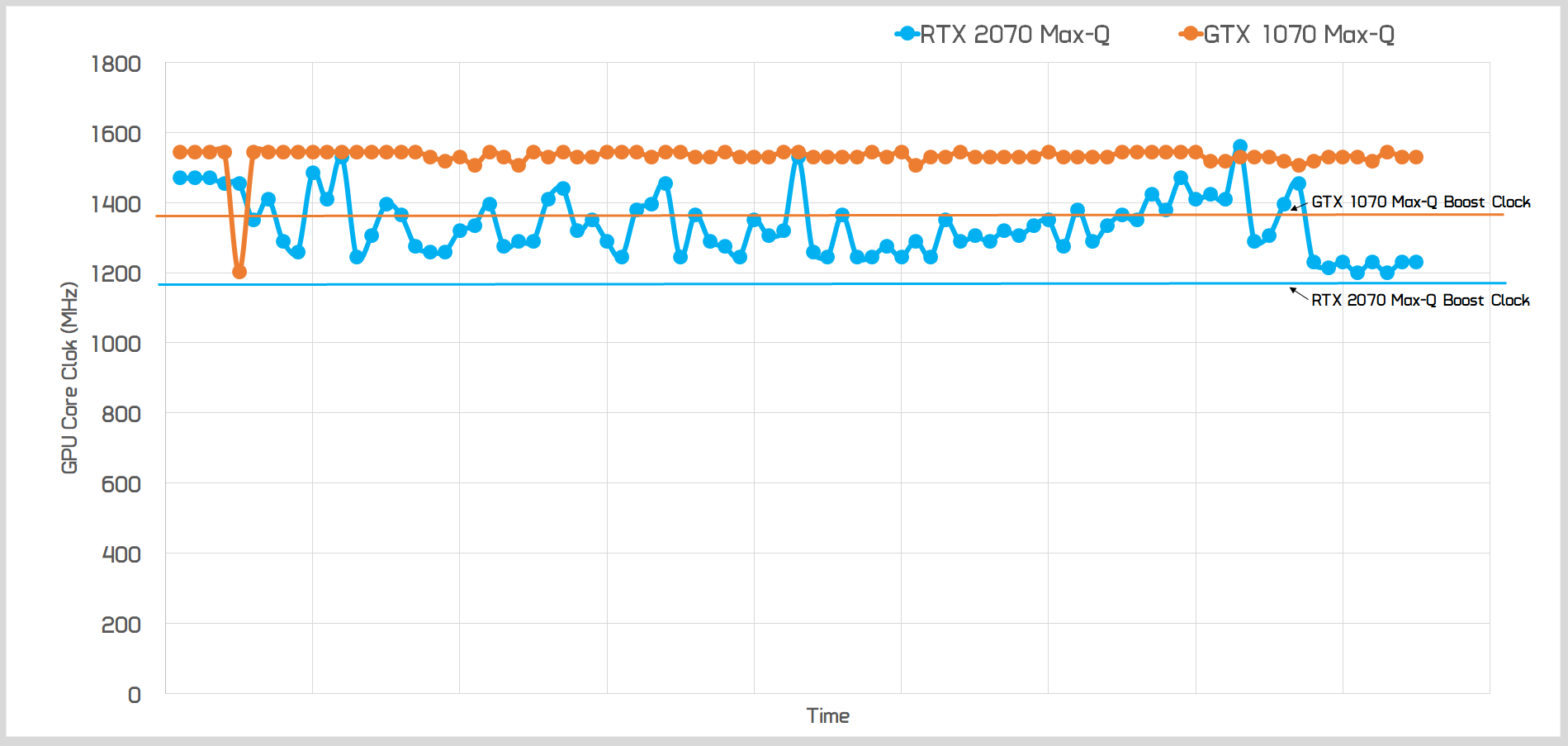
In terms of clock speeds, while the RTX 2070 Max-Q has a rated boost clock of merely 1185 MHz, thank you to Nvidia'southward GPU Boost, actual clock speeds in games were more effectually the 1250 to 1350 MHz mark. Then typically at least 100 MHz lower than the fully fledged laptop RTX 2070'due south boost clock, though the total version will besides boost higher. This is basically the same behaviour as the GTX 1070 Max-Q, which has a rated boost of 1379 MHz but sits more around the 1500 to 1600 MHz marking in games.
You should wait these results from any laptop with decent cooling, however those with poor cooling designs volition downclock more aggressively and effect in worse performance. Memory clocks don't modify, and hither the GDDR6 with the Max-Q variant is stuck at 12 Gbps.
Benchmarks
Nosotros're going to kick things off with a look at Battlefield i. This has been superseded by Battlefield V these days simply a lot of our existing data was for BF1, so nosotros'll start with that. Here the RTX 2070 Max-Q clocks in at only 7% faster than the GTX 1070 Max-Q, while offering a slight performance proceeds on the non-Max-Q variant. This is a decent start, just ideally you'd want to meet larger gains here.
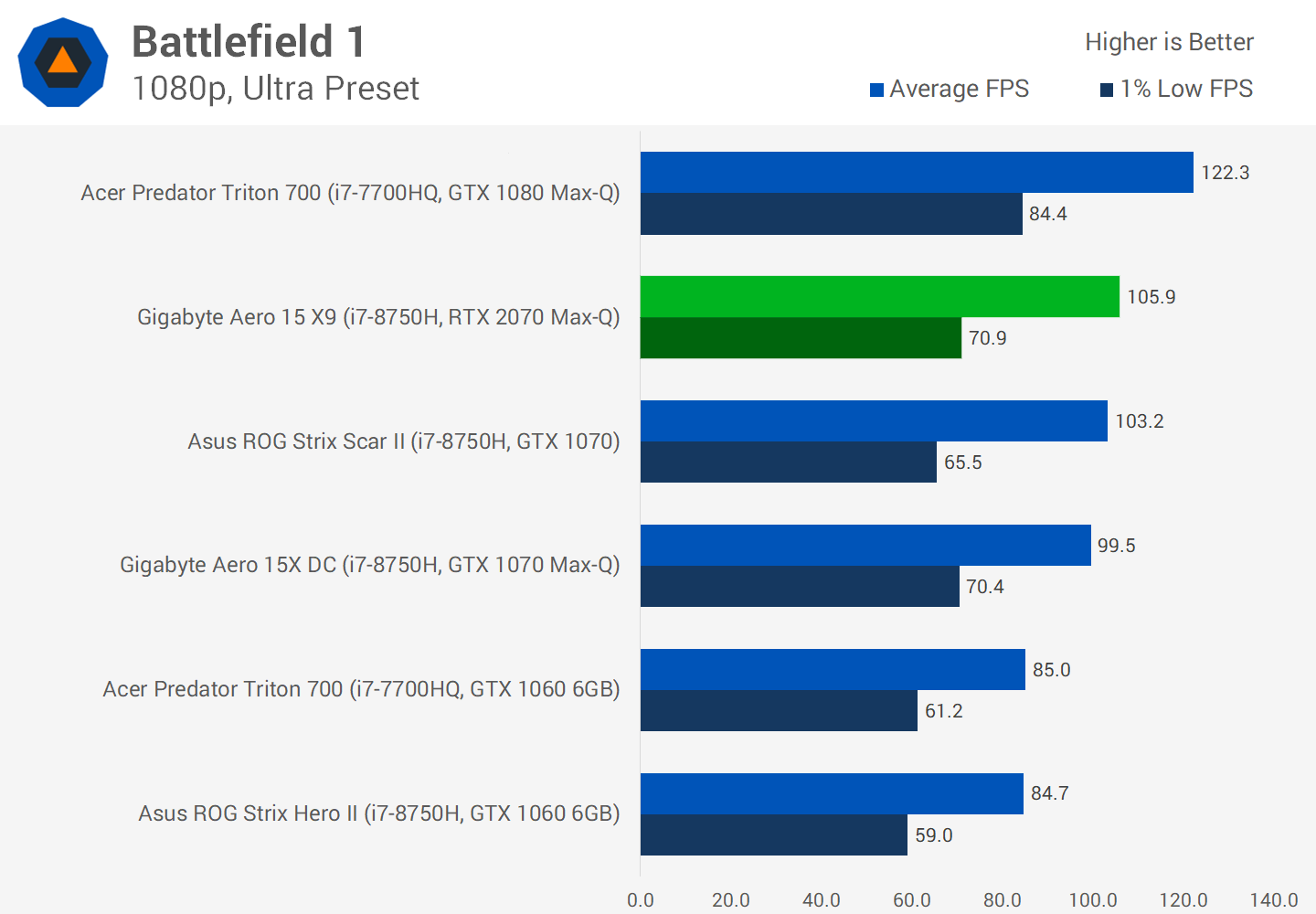
We know Wolfenstein Two is one of the near favorable games to Nvidia'southward new Turing compages, at least when comparing to Pascal. Here the RTX 2070 Max-Q commands a decent xv% performance lead over the GTX 1070 Max-Q. However the game is too one that heavily favors the fully fledged GPUs for some reason, so the regular old GTX 1070 is even so faster when looking at boilerplate performance.
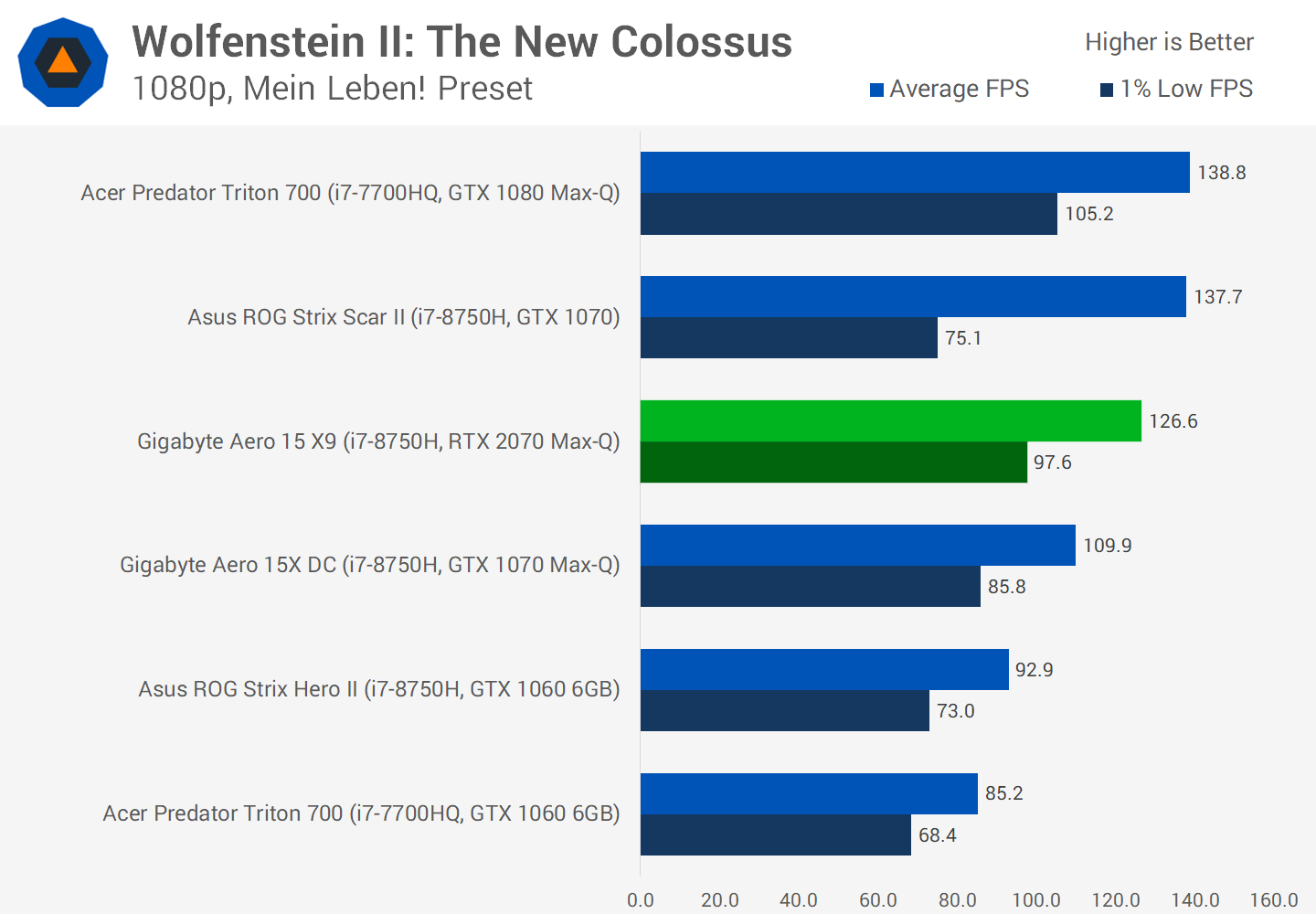
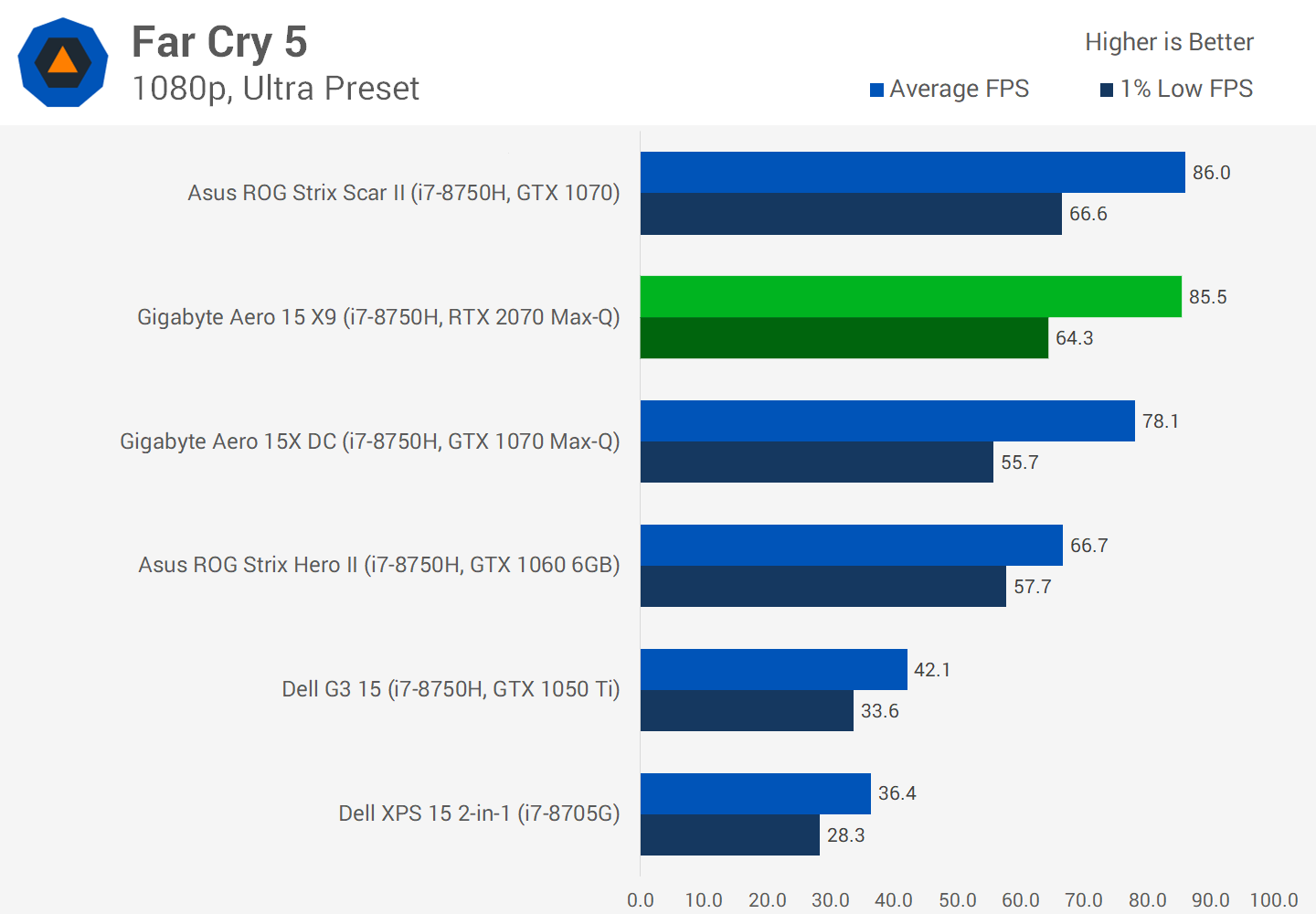
Far Cry 5 is a well optimized title and ane that nosotros like to benchmark with extensively. In this game, yous can wait the RTX 2070 to come up in with a nine percent performance lead over the GTX 1070, when comparing Max-Q versions. That does increment to a 15% atomic number 82 in 1% lows though, which is prissy to see. When comparison the Max-Q 2070 to the full GTX 1070, performance is virtually equal.
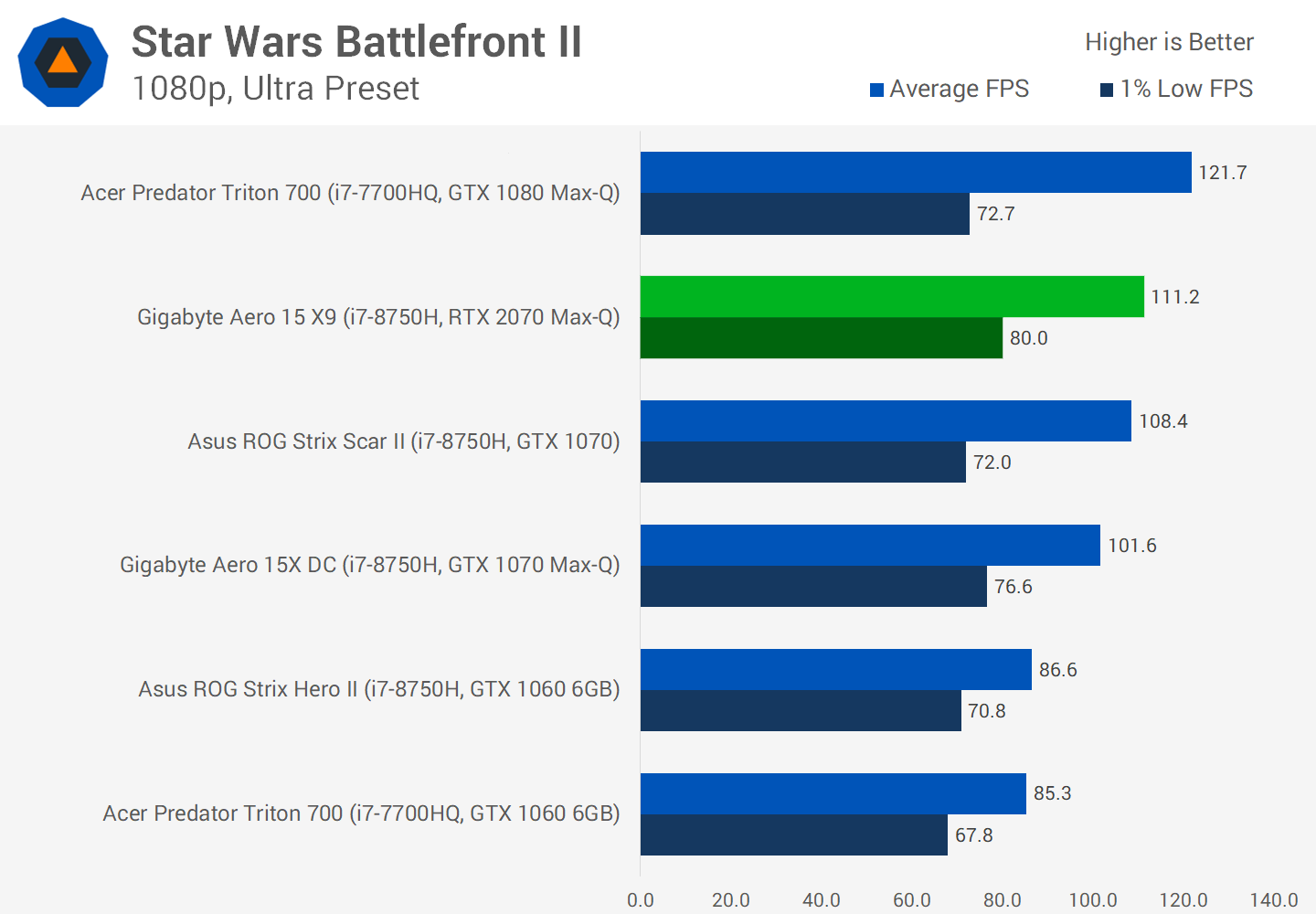
In Star Wars Battlefront 2, the RTX 2070 is around 10 percentage faster than the GTX 1070, again comparison Max-Q versions. The newer Turing GPU also holds a small advantage over the full GTX 1070, which seems to be typical for this new Max-Q model. We've only gone through 4 games then far, but in those games, the usual issue is the Max-Q 2070 delivering the same performance as the non Max-Q 1070, inside the same design constraints, so the aforementioned cooler
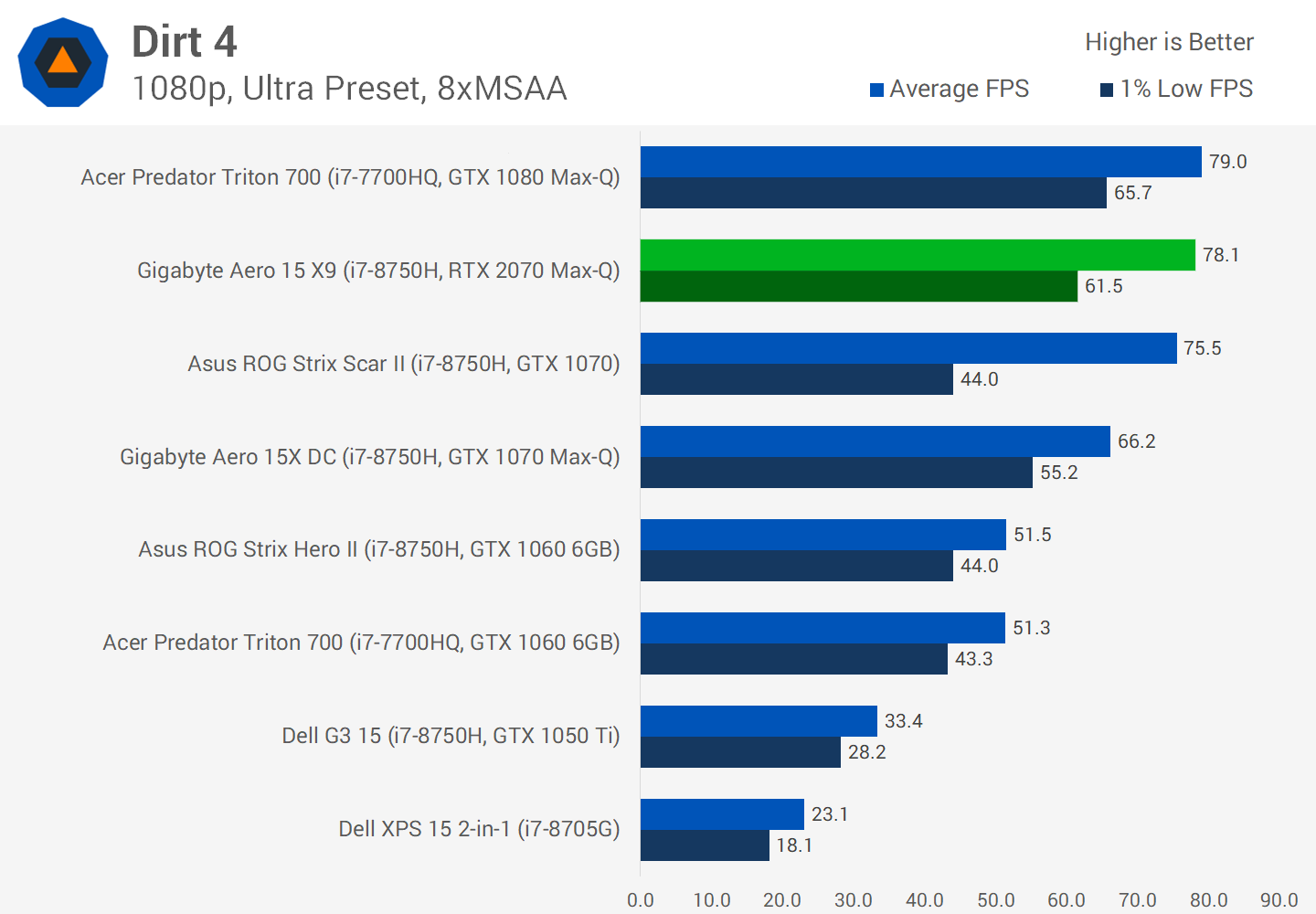
Dirt 4 is 1 of the most favourable games to the RTX 2070 Max-Q, the new GPU is eighteen percent faster on boilerplate and xi% faster in i% lows, relative to the GTX 1070 Max-Q. It's also a small amount faster than the standard GTX 1070.

Non every game you'll play on a laptop volition be GPU limited though. At 1080p, a great instance of that is Prey, which runs at around 100 FPS on modern laptops but in that location's not a lot of difference between well-nigh higher-terminate GPUs. The RTX 2070 Max-Q is only 3 percent faster than the GTX 1070 Max-Q, and it holds one of the smallest margins over the GTX 1060 6GB, at 16 pct. We believe this is more of a retentivity bandwidth issue than a CPU bottleneck.
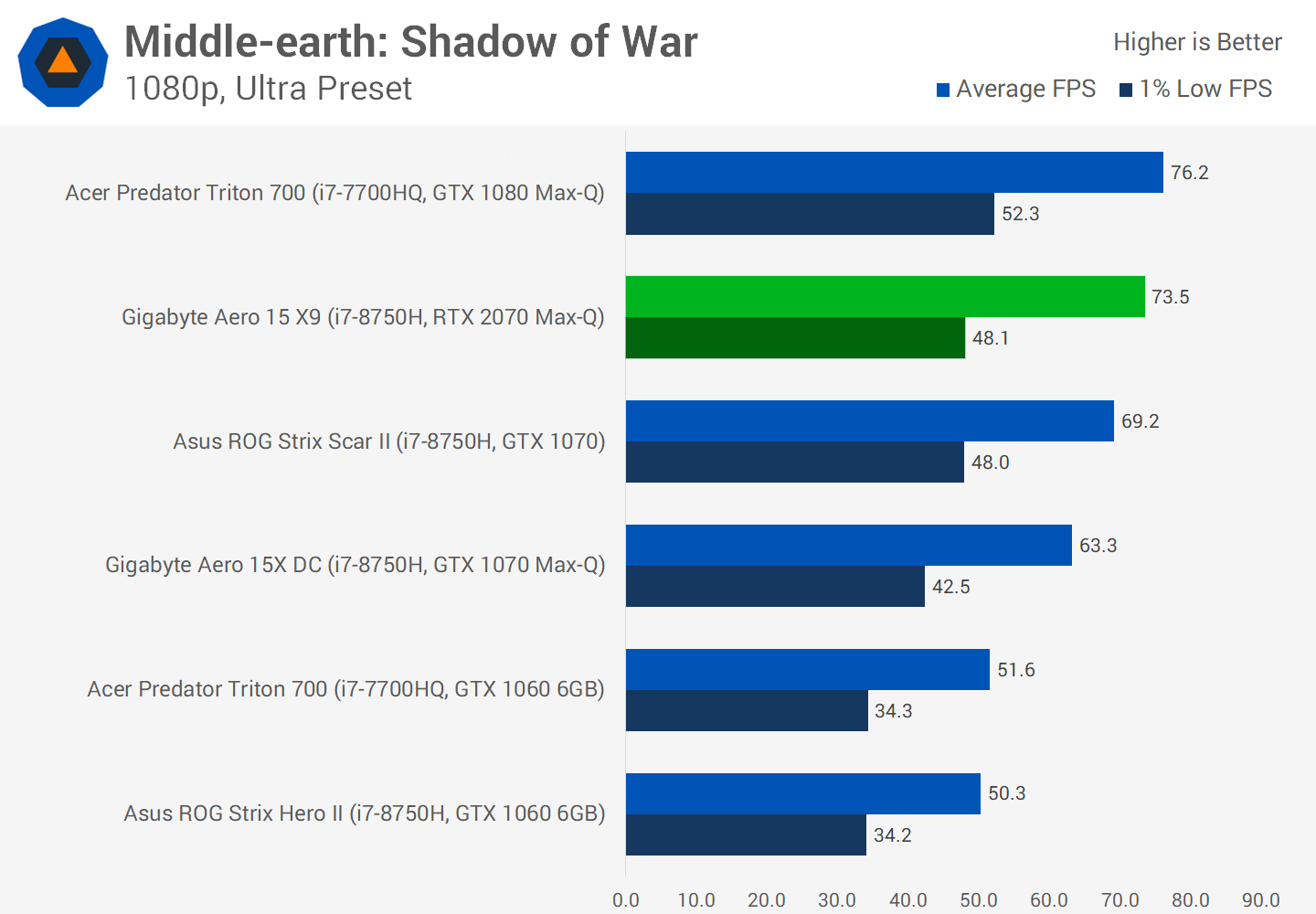
Middle-world Shadow of State of war is some other game that is favourable to Turing. Here the RTX 2070 is xvi% faster on average compared to the GTX 1070, looking at Max-Q variants. It'southward also 6% faster than the regular GTX 1070, which is 1 of the larger margins for this GPU.

Watch Dogs two is in a similar situation to Casualty, in that the game is quite demanding on the CPU. We spotted a 4% proceeds to average performance when comparing the RTX 2070 Max-Q to the GTX 1070 Max-Q, but no proceeds in terms of 1% low performance. Unlike with desktops, where you might pair the RTX 2070 with a much more powerful CPU, the 45W CPUs you're stuck with in nearly laptops tin limit the GPU, especially at 1080p.
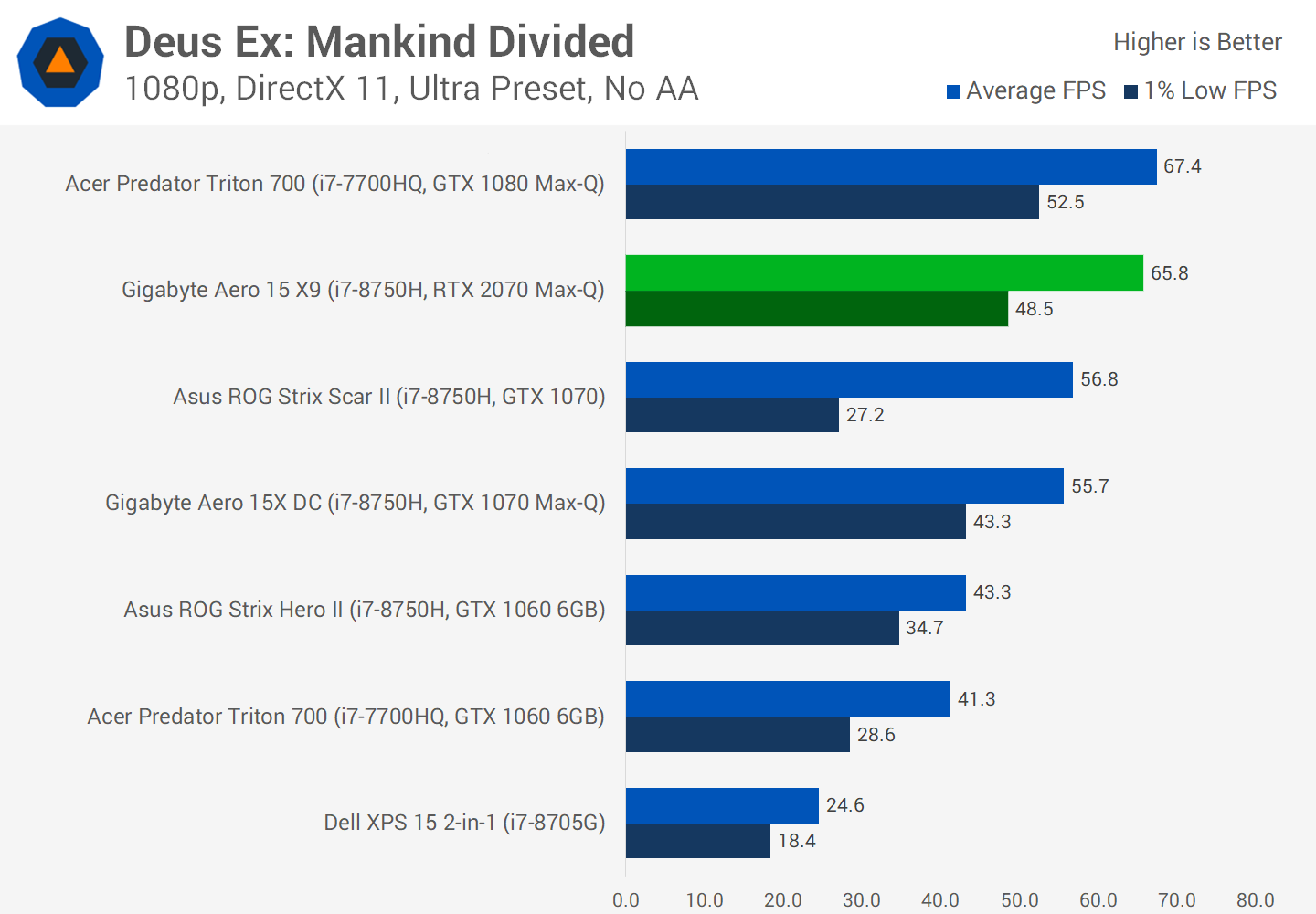
Couple more games we wanted to focus on here, Deus Ex Mankind Divided is an older title but is still very GPU limited. The RTX 2070 Max-Q is 18 percent faster than the GTX 1070 Max-Q, a big gain for Nvidia's new Turing architecture. Compared to the boilerplate result this is a bit of an outlier but nonetheless it'due south impressive.

Finally we take a game that not many people liked, Mass Effect Andromeda. A decent performance gain for the RTX 2070 Max-Q, coming in 13% faster than the GTX 1070 Max-Q. It's also 7% faster than the fully fledged GTX 1070.
Putting It All Together
Looking at the performance summary, across 18 games we can see that on average the RTX 2070 Max-Q is 10 percent faster than the GTX 1070 Max-Q it replaces. You can spot a couple of newer games, such as Assassin's Creed Odyssey which performs poorly on laptop hardware, forth with another largely CPU limited game in Hitman 2, plus two other new titles that deliver good gains in Battlefield Five and Resident Evil 2.

In full general though, you can await performance gains up to 18 percent, but equally low as three-4 pct in games that aren't GPU limited. And equally we're talking nearly laptops, there are more than instances where you'll encounter bottlenecks than a typical gaming desktop build, and this is an important consideration when comparing desktop and laptop GPUs...
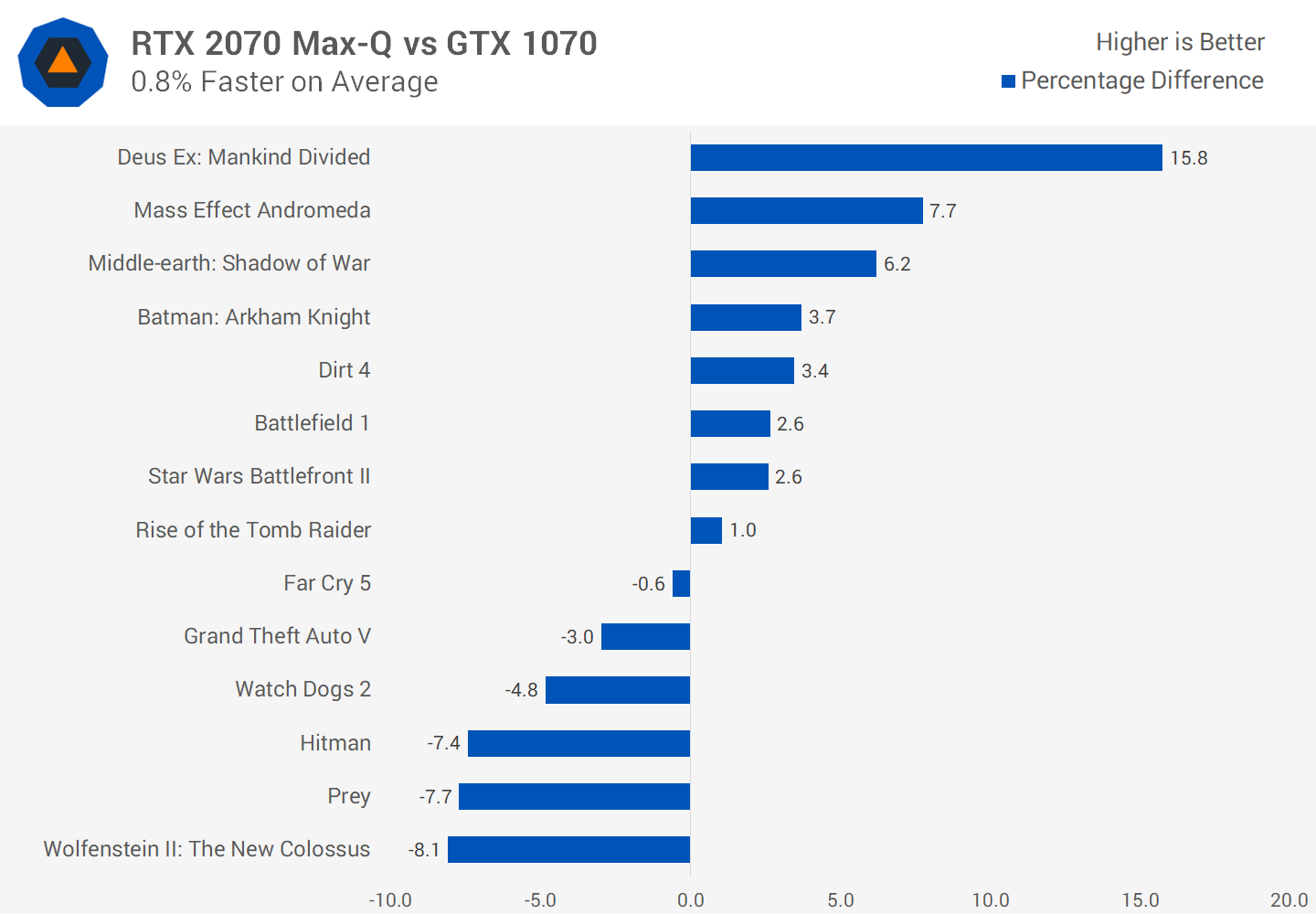
Comparing the RTX 2070 Max-Q to the regular GTX 1070 is a bit of a mixed bag. This new Max-Q GPU is at present delivering the performance of the last-gen fully fledged model, but in smaller, thinner and lighter systems with weaker cooling solutions. While non always the instance, GTX 1070 laptops tended to be on the larger end of the scale, withal with the RTX 2070 Max-Q we tin can await to come across that GPU in true thin and calorie-free gaming machines.
On the less positive side, the desktop RTX 2070 is 27% faster than the GTX 1070 on boilerplate. So it's pretty obvious how far behind the RTX 2070 Max-Q for laptops is, in comparison to the desktop equivalent.
Nosotros look the full non Max-Q model to be faster, simply information technology won't close this gap entirely. The Max-Q to Max-Q margin was x%, so we'd expect the total versions will have a similar 10% margin, not the 27% we saw with the desktop cards.
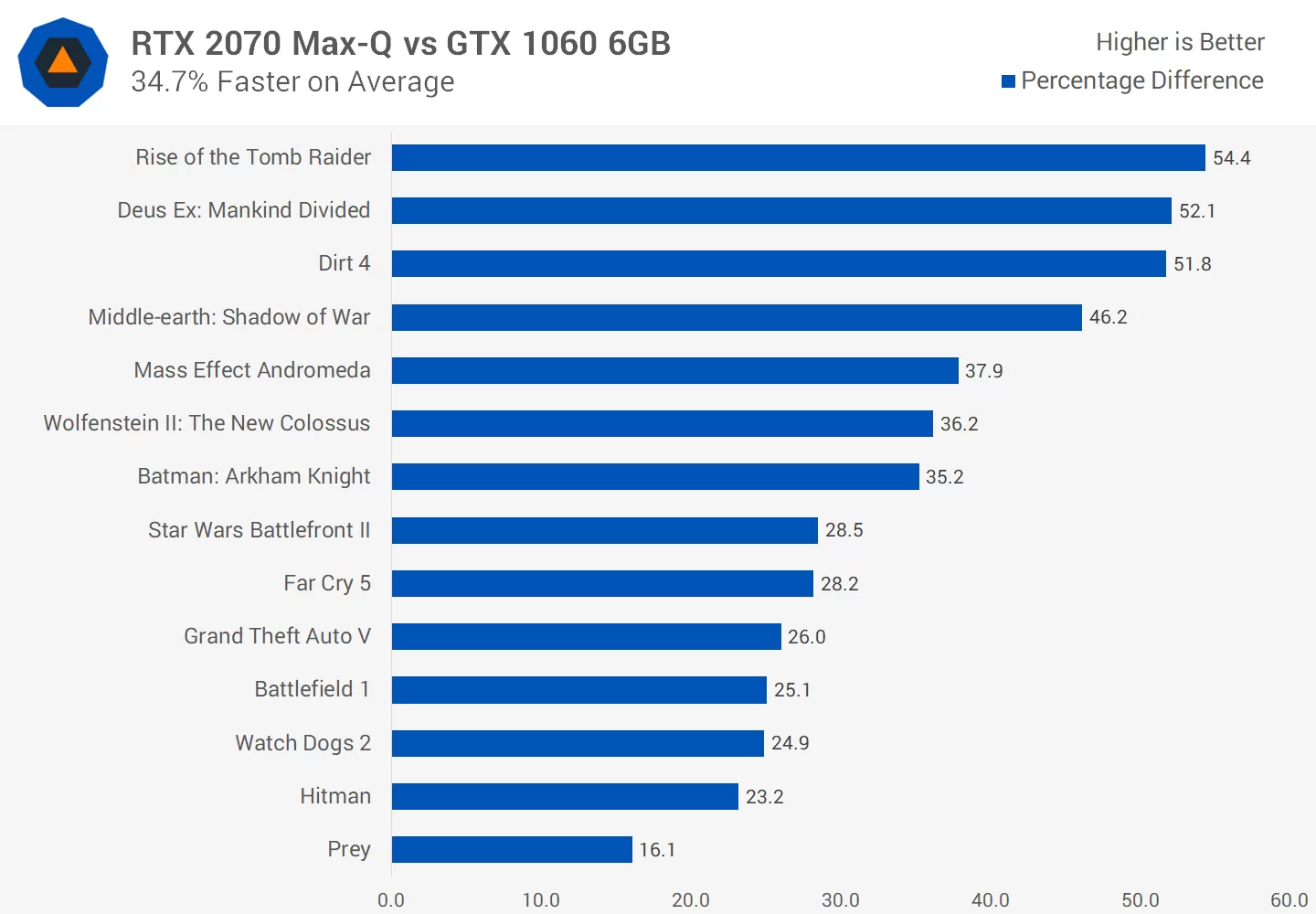
A couple of other comparisons to go, nosotros accept the RTX 2070 Max-Q compared to the GTX 1060 6GB, a very popular laptop GPU and a GPU that used to exist the maximum for sparse and low-cal laptops. The RTX 2070 Max-Q is 35% faster on average, which shows the progress that has been made in this sort of portable form factor.
Of course, RTX 2070 Max-Q laptops are a lot more than expensive, merely purely from a technical standpoint it's impressive to come across this level of performance gain within the aforementioned available space for cooling and ability delivery.
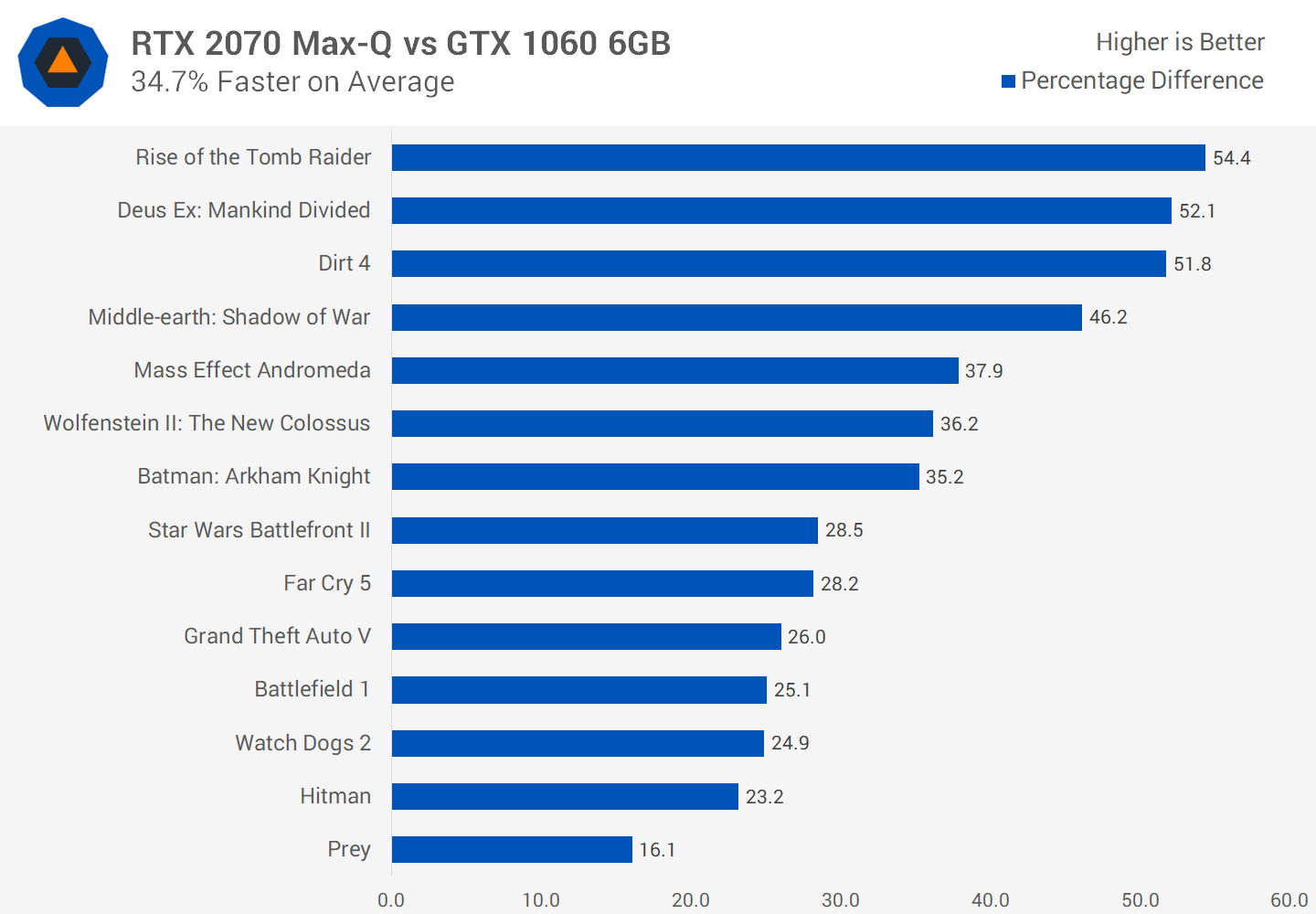
The RTX 2070 Max-Q is still slower than the GTX 1080 Max-Q, to the tune of ~6%. The GTX 1080 Max-Q is the next pace higher up the GTX 1070, and with the RTX 2070 Max-Q performing around GTX 1070 level, it makes sense the GTX 1080 Max-Q is nevertheless faster.
Of course, y'all'll be wondering how ray tracing performs with the RTX 2070 Max-Q. And the expert news is that… it works. We actually weren't expecting to encounter ray tracing in the laptop versions due to the TDP constraints merely it's in that location, even with the Max-Q variants. Notwithstanding, the 2070 Max-Q is only rated for 4 gigarays per second, lower than the desktop RTX 2060, then naturally information technology won't be equally good for ray tracing.
In our standard Battlefield 5 benchmark run, which does take reflected surfaces that activate the game'south DXR reflections, using just the depression ray tracing mode caused a pretty significant performance drop. Without DXR we were achieving an average of 86 FPS through the run, turning on DXR to Depression dropped that to 54 FPS, so we're talking nearly a sub sixty FPS feel at 1080p. Turning RTX upwards to ultra and… yeah that drops even further to just a 44 FPS average. We don't think many people volition want to play a game like BFV at below 60 FPS, even so we're likewise waiting to see how truthful Nvidia's DLSS claims plough out to be.
Endmost Thoughts
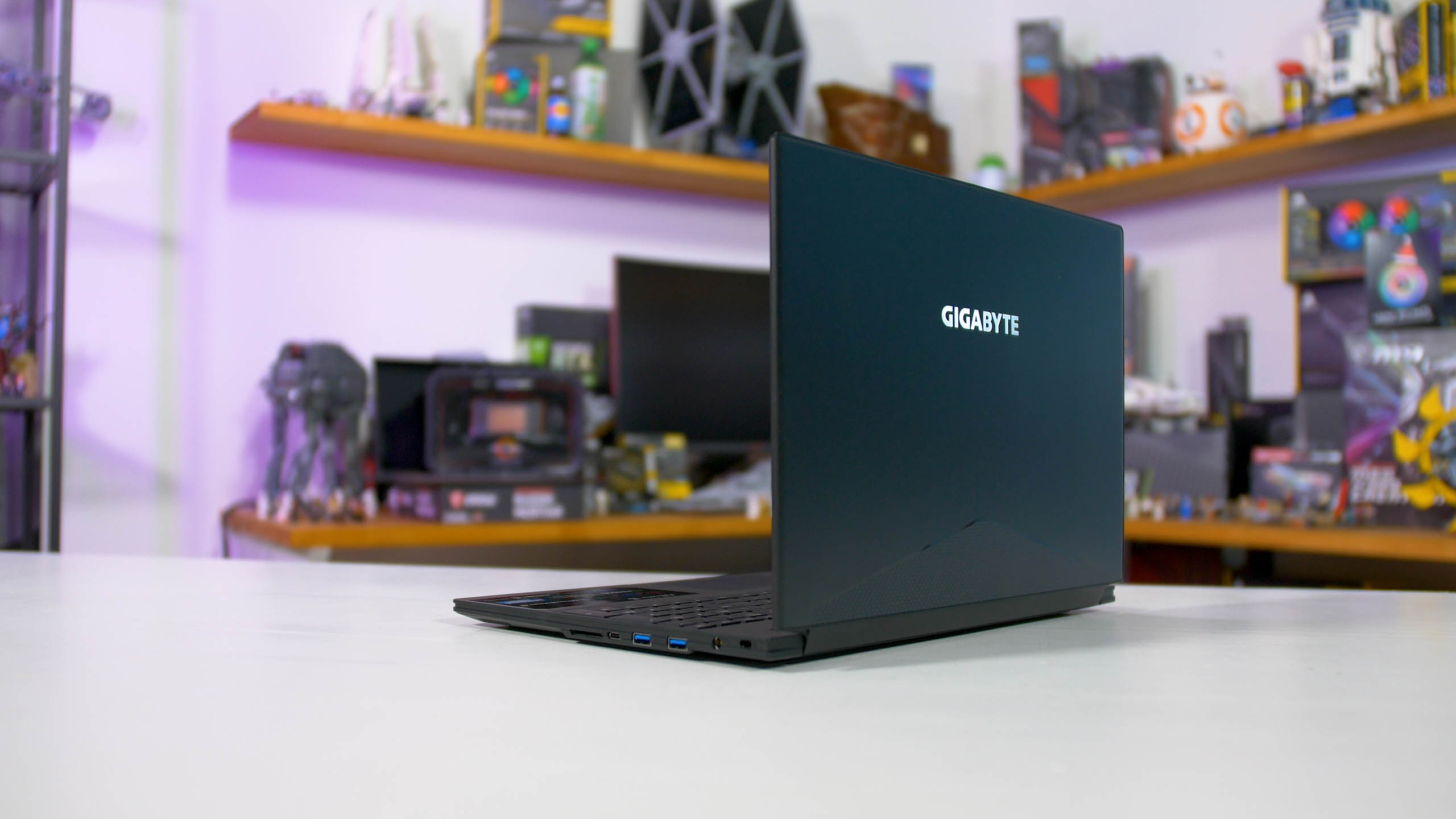
While Nvidia's RTX line has been largely disappointing on the desktop, laptops are an entirely different story with dissimilar price points, categories and considerations to make.
Nosotros want to pause this down into a few sections. Start, the naming scheme is non good enough. With Nvidia downclocking all RTX GPUs for laptops, these are no longer directly equivalents to their desktop counterparts and we wish they used different names, even if slightly, to avoid confusion.
On the performance front, nosotros're getting ten% more out of the RTX 2070 Max-Q compared to the GTX 1070 Max-Q. For the same production category – which means the same type of laptop, with a similar design, size, weight and cooler – we tin await a modest 10% proceeds. That'southward ok. It's fine. Information technology'southward nothing astonishing, but information technology is faster in the same category.
The expert news is laptops are around the same price besides. Comparison launch prices, portable GTX 1070 Max-Q laptops launched in the $ii,200 to $two,400 range, and that'due south where RTX 2070 Max-Q laptops take launched with similar hardware configurations. If you're looking for new laptop options correct now, yous will also observe GTX 1070 Max-Q laptops discounted to an appropriate toll relative to newer RTX 2070 models, and then you can save $100-300 depending on the model.
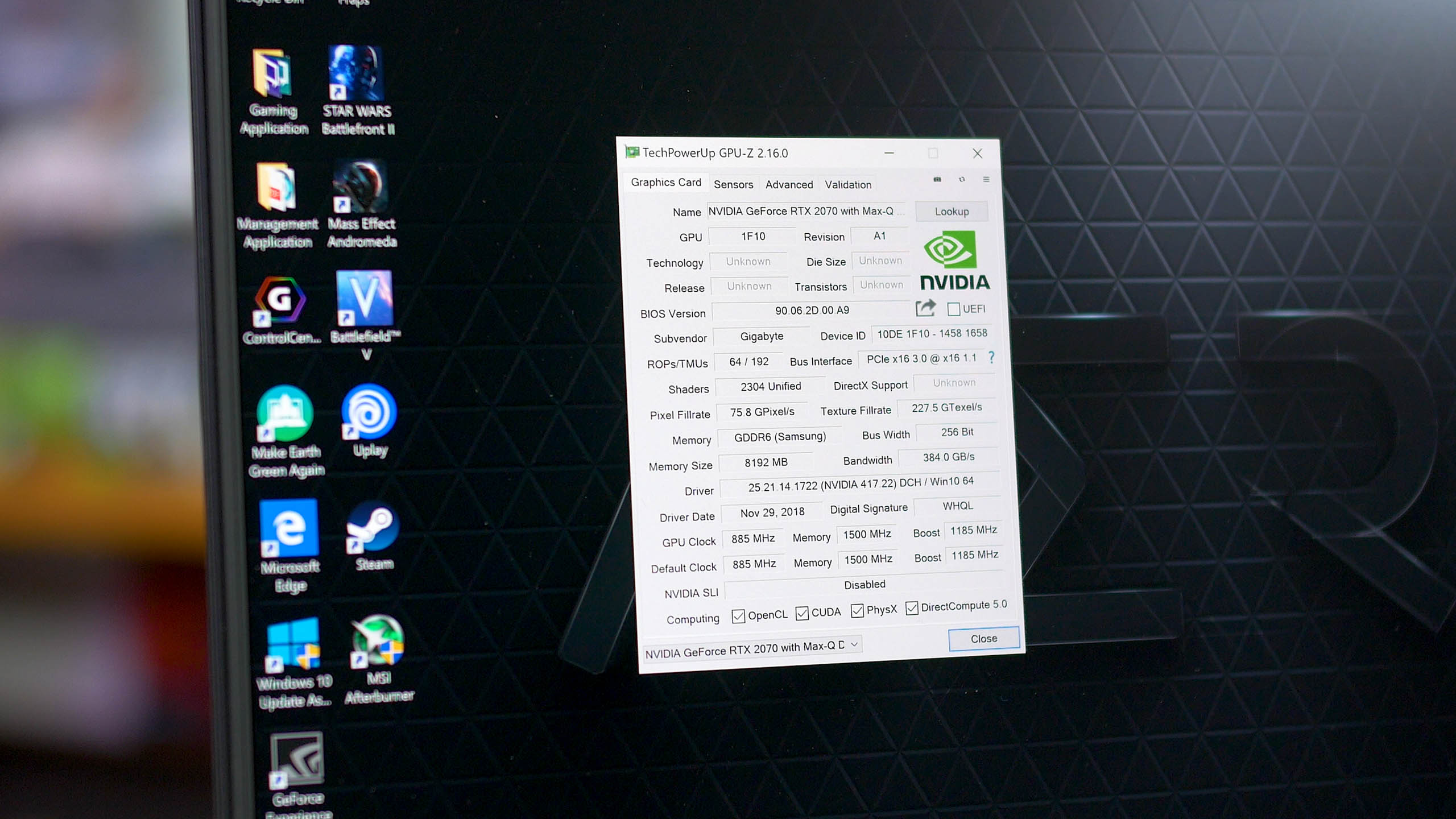
For some people, RTX GPUs similar the RTX 2070 Max-Q will bring additional benefits similar ray tracing and DLSS depending on how much stock you place on their importance. Neither are widespread technologies right now, and in our opinion it's not something worth because with your purchase.
While on the desktop information technology's all virtually raw performance and bang for buck, with laptops there'due south the added factor of performance per watt, or how much you can become out of a given cooler design. Equally Turing is congenital on 12nm, compared to 16nm for Pascal, at that place hasn't been a pregnant uptick in that department, so realistically nosotros were never going to encounter a large leap in operation within the same given class cistron.
Laptop upgrade cycles are also different to the desktop. Most people buying an RTX laptop aren't just getting a new GPU, they'll likely be upgrading the CPU, memory, storage, brandish and design, which can all add value to a purchase. So while the generation on generation gains are simply near x% of raw operation for the RTX 2070 Max-Q, a large number of buyers will come across bodily gains far college than this with their upgrade one time you cistron in other components and overall system functioning.
Shopping Shortcuts:
- Gigabyte Aero 15 X9 on Amazon
- Gigabyte Aero 15X v8 on Amazon
- RTX 2070 Laptops on Amazon
- GTX 1070 Laptops on Amazon
- GeForce RTX 2060 on Amazon, Newegg
- GeForce RTX 2070 on Amazon, Newegg
- GeForce RTX 2080 on Amazon, Newegg
- GeForce RTX 2080 Ti on Amazon, Newegg
- Radeon RX Vega 56 on Amazon, Newegg
- Radeon RX Vega 64 on Amazon, Newegg
- Radeon RX 570 on Amazon, Newegg
- Radeon RX 580 on Amazon, Newegg
Source: https://www.techspot.com/review/1792-geforce-rtx-2070-max-q-laptop/
Posted by: perrylitsee.blogspot.com


0 Response to "Nvidia GeForce RTX 2070 Max-Q Review"
Post a Comment